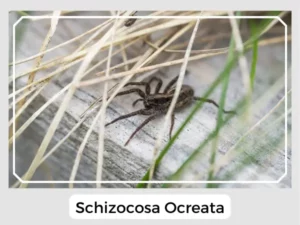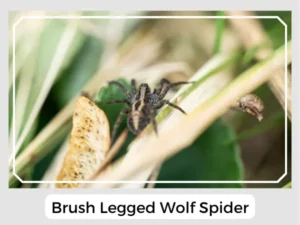The Schizocosa ocreata, commonly known as the brush-legged wolf spider, is a captivating creature that roams the underbrush and leaf litter of forests across North America. These spiders are solitary hunters, known for their agility and the unique brushing hairs on their legs, which play a crucial role in their mating rituals. Their presence in various ecosystems highlights their importance in maintaining the delicate balance of natural pest control, making them a fascinating subject of study for both arachnologists and nature enthusiasts.
Female Brush-legged Wolf spiders lay eggs in a silk sac, which they guard fervently until they hatch. The sac contains numerous eggs, ensuring the survival of at least some offspring in the face of predation.
Upon hatching, spiderlings are pale and small, gradually gaining their adult coloration and size through successive molts. They disperse shortly after emerging to lead solitary lives.
Unlike many spiders, Schizocosa ocreata does not use webs to catch prey. Instead, they are active hunters, using their speed and agility to chase down meals. They may, however, spin silk retreats or sacs for their eggs. 
Yes, Schizocosa ocreata spiders are venomous, like most spiders. However, their venom is designed primarily for subduing their small insect prey and is not harmful to humans under normal circumstances.
While they can bite if threatened or handled, the bite of a Schizocosa ocreata spider is not considered dangerous to humans. It might cause mild irritation or redness but is unlikely to result in serious health issues.
Natural Predator: Brush legged wolf spiders play a critical role as natural predators in their ecosystem, controlling the populations of insects and thereby contributing to the ecological balance.
Prey-Predator Dynamics: They fall into the diet of larger predators, including birds, reptiles, and larger mammals, showcasing the intricate web of prey-predator dynamics in their habitats.
Relationship with Humans: These spiders have a largely unnoticed yet beneficial relationship with humans, as they help in controlling pest populations in gardens and farms without the need for chemical pesticides. 
| Distribution | Found across North America, particularly in the United States and parts of Canada. |
| Habitat | Prefers forest floors, grasslands, and suburban gardens where leaf litter and underbrush provide cover. |
| Diet | Primarily insects and other small invertebrates. |
| Lifespan | Typically lives for about 1 to 2 years. |
| Predators | Includes birds, reptiles, and larger mammals. |
| IUCN Conservation Status | Not listed |
In conclusion, the Brush legged wolf spider, with its distinctive physical traits and intriguing behaviors, plays a pivotal role in the balance of ecosystems. While often overlooked, their presence is a testament to the complexity of natural habitats and the importance of every organism within it.
The Schizocosa ocreata, commonly known as the brush-legged wolf spider, is a captivating creature that roams the underbrush and leaf litter of forests across North America. These spiders are solitary hunters, known for their agility and the unique brushing hairs on their legs, which play a crucial role in their mating rituals. Their presence in various ecosystems highlights their importance in maintaining the delicate balance of natural pest control, making them a fascinating subject of study for both arachnologists and nature enthusiasts.
Female Brush-legged Wolf spiders lay eggs in a silk sac, which they guard fervently until they hatch. The sac contains numerous eggs, ensuring the survival of at least some offspring in the face of predation.
Upon hatching, spiderlings are pale and small, gradually gaining their adult coloration and size through successive molts. They disperse shortly after emerging to lead solitary lives.
Unlike many spiders, Schizocosa ocreata does not use webs to catch prey. Instead, they are active hunters, using their speed and agility to chase down meals. They may, however, spin silk retreats or sacs for their eggs. 
Yes, Schizocosa ocreata spiders are venomous, like most spiders. However, their venom is designed primarily for subduing their small insect prey and is not harmful to humans under normal circumstances.
While they can bite if threatened or handled, the bite of a Schizocosa ocreata spider is not considered dangerous to humans. It might cause mild irritation or redness but is unlikely to result in serious health issues.
Natural Predator: Brush legged wolf spiders play a critical role as natural predators in their ecosystem, controlling the populations of insects and thereby contributing to the ecological balance.
Prey-Predator Dynamics: They fall into the diet of larger predators, including birds, reptiles, and larger mammals, showcasing the intricate web of prey-predator dynamics in their habitats.
Relationship with Humans: These spiders have a largely unnoticed yet beneficial relationship with humans, as they help in controlling pest populations in gardens and farms without the need for chemical pesticides. 
| Distribution | Found across North America, particularly in the United States and parts of Canada. |
| Habitat | Prefers forest floors, grasslands, and suburban gardens where leaf litter and underbrush provide cover. |
| Diet | Primarily insects and other small invertebrates. |
| Lifespan | Typically lives for about 1 to 2 years. |
| Predators | Includes birds, reptiles, and larger mammals. |
| IUCN Conservation Status | Not listed |
In conclusion, the Brush legged wolf spider, with its distinctive physical traits and intriguing behaviors, plays a pivotal role in the balance of ecosystems. While often overlooked, their presence is a testament to the complexity of natural habitats and the importance of every organism within it.